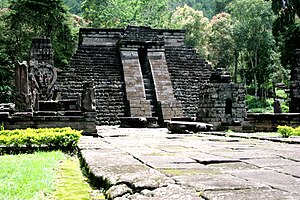Sukuh
7°37′38″S 111°7′52″E / 7.62722°S 111.13111°E

Sukuh (
Background
Sukuh is one of several temples built on the northwest slopes of Mount Lawu in the 15th century. By this time, Javanese religion and art had diverged from Indian precepts that had been so influential on temple styles during the 8th–10th centuries. This was the last significant area of temple building in Java before the island's courts were converted to Islam in the 16th century. It is difficult for historians to interpret the significance of these antiquities due to the temple's distinctiveness and the lack of records of Javanese ceremonies and beliefs of the era.[2]
The founder of Candi Sukuh thought that the slope of Mount Lawu was a sacred place for worshiping the ancestors and nature spirits and for observance of the fertility cults.
In 1815,
Architecture

The central pyramid of the complex sits at the rear of the highest of three terraces. Originally, worshippers would have accessed the complex through a gateway at the western or lowest terrace. To the left of the gate is a carving of a monster eating a man, birds in a tree, and a dog, which is thought to be a chronogram representing 1437 CE, the likely date of the temple's consecration. There is an obvious depiction of sexual intercourse in relief on the floor at the entrance where it shows a paired lingam which is represented physiologically by the (phallus) and yoni, which is represented bodily by the (vagina). Genitalia is portrayed on several statues from the site, which is unique among Javanese classical monuments.
The main structure of the Sukuh temple is like no other ancient edifice; it is a truncated

The wall of the main monument has a relief portraying two men forging a weapon in a smithy with a dancing figure of Ganesha, the most important Tantric deity, having a human body and the head of an elephant. In Hindu-Java mythology, the smith is thought to possess not only the skill to alter metals but also the key to spiritual transcendence.[5] Smiths drew their powers to forge a kris from the god of fire and a smithy is considered as a shrine. Hindu-Javanese kingship was sometimes legitimated and empowered by the possession of a kris.

The elephant head figure with a crown in the smithy relief depicts
Other statues in Candi Sukuh include a life-sized male figure with his hand grasping his own
See also
- Pyramid temples in Indonesia
- Candi Kethek, 5 terraces
- Lebak Cibedug, 9 terraces
- Pugung Raharjo, 5 terraces
- In Java
- Candi Ceto
- Candi of Indonesia
- Prambanan Temple, 6th-9th century UNESCO heritage Hindu temple in Central Java.
- Sunda Kingdom, 7th-16th century Indianised Hindu kingdom in Western and Central Java.
- Taruma Kingdom, 2nd-6th century Indianised Hindu kingdom of Western Java.
- Other related topics
- Greater India
- Indianisation
- History of Indian influence on Southeast Asia
- Hinduism in Indonesia
- Buddhism in Indonesia
- List of places with columnar jointed volcanics
References
- ^ Wassana Im-em; Kullawee Siriratmongkhon (19 August 2002). "Gender and Pleasure" (PDF). Australian National University. Archived from the original (PDF) on 9 June 2007. Retrieved 23 July 2023.
- ISBN 962-593-244-5.
- ^ ISBN 0-8248-2779-1.
- ISBN 81-7017-404-X.
- ^ a b c Stanley J. O'Connor (1985). "Metallurgy and Immortality at Caṇḍi Sukuh, Central Java". Indonesia. 39: 53–70.
- ^ "Candi Sukuh, Candi Unik Berbentuk Trapesium". 12 March 2012.
